 W
WThe 17pdr SP Achilles was a British variant of the American M10 tank destroyer armed with the British Ordnance QF 17 pounder high-velocity 76.2 mm anti-tank gun in place of the M10's considerably less powerful 3 inch Gun M7. A total of 1,100 M10s were converted to Achilles, making it the second most numerous armoured fighting vehicle to carry the 17 pounder gun, behind the Sherman Firefly.
 W
WA20 was a British tank design by Harland and Wolff to meet an Army requirement for an infantry tank that could replace the Matilda II and Valentine tank. It was designed in the expectation that conditions would be similar to those of the First World War.
 W
WThe Tank, Infantry, Mk IV (A22) Churchill was a British heavy infantry tank used in the Second World War, best known for its heavy armour, large longitudinal chassis with all-around tracks with multiple bogies, its ability to climb steep slopes, and its use as the basis of many specialist vehicles. It was one of the heaviest Allied tanks of the war.
 W
WTank, Infantry, Black Prince (A43) is the name that was assigned to an experimental development of the Churchill tank with a larger, wider hull and a QF 17-pounder (76 mm) gun. It was named after Edward, the Black Prince, a famous 14th century military leader.
 W
WHobart's Funnies is the nickname given to a number of specialist armoured fighting vehicles derived from tanks operated during the Second World War by units of the 79th Armoured Division of the British Army or by specialists from the Royal Engineers.
 W
WThe Cromwell tank, officially Tank, Cruiser, Mk VIII, Cromwell (A27M), was one of the series of cruiser tanks fielded by Britain in the Second World War. Named after the English Civil War leader Oliver Cromwell, the Cromwell was the first tank put into service by the British to combine high speed from a powerful and reliable engine, and reasonable armour. The intended dual-purpose high velocity gun could not be fitted in the turret and the medium velocity dual purpose gun fitted proved inadequate. An improved version with a high velocity gun became the Comet tank.
 W
WThe Cromwell tank, officially Tank, Cruiser, Mk VIII, Cromwell (A27M), was one of the series of cruiser tanks fielded by Britain in the Second World War. Named after the English Civil War leader Oliver Cromwell, the Cromwell was the first tank put into service by the British to combine high speed from a powerful and reliable engine, and reasonable armour. The intended dual-purpose high velocity gun could not be fitted in the turret and the medium velocity dual purpose gun fitted proved inadequate. An improved version with a high velocity gun became the Comet tank.
 W
WThe Centurion was the primary British army main battle tank of the post-Second World War period. Introduced in 1945, it is widely considered to be one of the most successful post-war tank designs, remaining in production into the 1960s, and seeing combat in the front lines into the 1980s. The chassis was also adapted for several other roles, and these have remained in service to this day.
 W
WHobart's Funnies is the nickname given to a number of specialist armoured fighting vehicles derived from tanks operated during the Second World War by units of the 79th Armoured Division of the British Army or by specialists from the Royal Engineers.
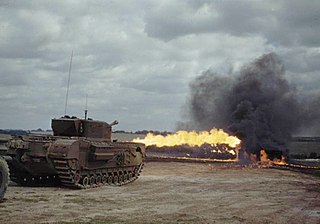 W
WThe Churchill Crocodile was a British flame-throwing tank of late Second World War. It was a variant of the Tank, Infantry, Mk IV (A22) Churchill Mark VII, although the Churchill Mark IV was initially chosen to be the base vehicle.
 W
WHobart's Funnies is the nickname given to a number of specialist armoured fighting vehicles derived from tanks operated during the Second World War by units of the 79th Armoured Division of the British Army or by specialists from the Royal Engineers.
 W
WThe Tank, Infantry, Mk IV (A22) Churchill was a British heavy infantry tank used in the Second World War, best known for its heavy armour, large longitudinal chassis with all-around tracks with multiple bogies, its ability to climb steep slopes, and its use as the basis of many specialist vehicles. It was one of the heaviest Allied tanks of the war.
 W
WThe Tank, Infantry, Mk IV (A22) Churchill was a British heavy infantry tank used in the Second World War, best known for its heavy armour, large longitudinal chassis with all-around tracks with multiple bogies, its ability to climb steep slopes, and its use as the basis of many specialist vehicles. It was one of the heaviest Allied tanks of the war.
 W
WThe Tank, Infantry, Mk IV (A22) Churchill was a British heavy infantry tank used in the Second World War, best known for its heavy armour, large longitudinal chassis with all-around tracks with multiple bogies, its ability to climb steep slopes, and its use as the basis of many specialist vehicles. It was one of the heaviest Allied tanks of the war.
 W
WThe Tank, Infantry, Mk IV (A22) Churchill was a British heavy infantry tank used in the Second World War, best known for its heavy armour, large longitudinal chassis with all-around tracks with multiple bogies, its ability to climb steep slopes, and its use as the basis of many specialist vehicles. It was one of the heaviest Allied tanks of the war.
 W
WThe Tank, Infantry, Mk IV (A22) Churchill was a British heavy infantry tank used in the Second World War, best known for its heavy armour, large longitudinal chassis with all-around tracks with multiple bogies, its ability to climb steep slopes, and its use as the basis of many specialist vehicles. It was one of the heaviest Allied tanks of the war.
 W
WThe Comet tank or Tank, Cruiser, Comet I (A34) was a British cruiser tank that first saw use near the end of World War II during the Invasion of Germany. It was developed from the earlier Cromwell tank and mounted the new 17 pdr High Velocity (HV) gun, in a lower profile, partly-cast turret. This gun was effective against late-war German tanks, including the Panther at medium range, and the Tiger. The tank was widely respected as one of the best British tanks of the war, and continued in service afterwards.
 W
WThe Cruiser tank Mk V or A13 Mk III Covenanter was a British cruiser tank of the Second World War. The Covenanter was the first cruiser tank design to be given a name. Designed by the London, Midland and Scottish Railway as a better-armoured replacement for the Cruiser Mark IV, it was ordered into production in 1939 before pilot models were built. Problems with the design became apparent only after production was under way.
 W
WThe Cromwell tank, officially Tank, Cruiser, Mk VIII, Cromwell (A27M), was one of the series of cruiser tanks fielded by Britain in the Second World War. Named after the English Civil War leader Oliver Cromwell, the Cromwell was the first tank put into service by the British to combine high speed from a powerful and reliable engine, and reasonable armour. The intended dual-purpose high velocity gun could not be fitted in the turret and the medium velocity dual purpose gun fitted proved inadequate. An improved version with a high velocity gun became the Comet tank.
 W
WThe Tank, Cruiser, Mk I (A9) was a British cruiser tank of the interwar period. It was the first cruiser tank: a fast tank designed to bypass the main enemy lines and engage the enemy's lines of communication, along with enemy tanks. The Cruiser Mk II was a more heavily armoured adaptation of the Mark I, developed at much the same time.
 W
WThe Tank, Cruiser, Mk II (A10), was a cruiser tank developed alongside the A9 cruiser tank, and was intended to be a heavier, infantry tank version of that type. In practice, it was not deemed suitable for the infantry tank role and was classified as a "heavy cruiser".
 W
WThe Tank, Cruiser, Mk III, also known by its General Staff specification number A13 Mark I, was a British cruiser tank of the Second World War. It was the first British cruiser tank to use the Christie suspension system, which gave higher speeds and better cross-country performance; previous cruiser tank models had used triple wheeled bogie suspension.
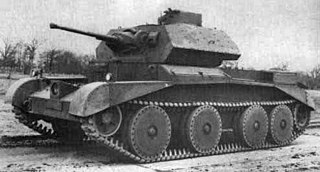 W
WThe Cruiser Tank Mk IV was a British cruiser tank of the Second World War. It followed directly on from the Tank, Cruiser, Mk III. The first Mk IVs were Mk IIIs with extra armour fitted to the turret. Later Mk IVAs were built with the complete extra armour. The tank was used in France in 1940 and in the early part of the war in North Africa, before being withdrawn from service. In total, 955 of these tanks were built.
 W
WThe Tank, Cruiser, Challenger (A30) was a British tank of World War II. It mounted the QF 17-pounder anti-tank gun on a chassis derived from the Cromwell tank to add anti-tank firepower to the cruiser tank units. The design compromises made in fitting the large gun onto the Cromwell chassis resulted in a tank with a powerful weapon and reduced armour. The extemporised 17-pounder Sherman Firefly conversion of the US-supplied Sherman was easier to produce and, with delays in production, only 200 Challengers were built. The Challenger was able to keep up with the fast Cromwell tank and was used with them.
 W
WThe A.15 Tank, Cruiser, Mk VI or Crusader was one of the primary British cruiser tanks during the early part of the Second World War. Over 5,000 tanks were manufactured and they made important contributions to the British victories during the North African Campaign. The Crusader tank would not see active service beyond Africa, but the chassis of the tank was modified to create anti-aircraft, fire support, observation, communication, bulldozer and recovery vehicle variants.
 W
WThe A.15 Tank, Cruiser, Mk VI or Crusader was one of the primary British cruiser tanks during the early part of the Second World War. Over 5,000 tanks were manufactured and they made important contributions to the British victories during the North African Campaign. The Crusader tank would not see active service beyond Africa, but the chassis of the tank was modified to create anti-aircraft, fire support, observation, communication, bulldozer and recovery vehicle variants.
 W
WThe A.15 Tank, Cruiser, Mk VI or Crusader was one of the primary British cruiser tanks during the early part of the Second World War. Over 5,000 tanks were manufactured and they made important contributions to the British victories during the North African Campaign. The Crusader tank would not see active service beyond Africa, but the chassis of the tank was modified to create anti-aircraft, fire support, observation, communication, bulldozer and recovery vehicle variants.
 W
WDD or Duplex Drive tanks, nicknamed "Donald Duck tanks", were a type of amphibious swimming tank developed by the British during the Second World War. The phrase is mostly used for the Duplex Drive variant of the M4 Sherman medium tank, that was used by the Western Allies during and after the Normandy Landings in June 1944.
 W
WThe Tank, Heavy Assault, A33 (Excelsior) was a British experimental heavy tank based on the Cromwell (A27) design developed in the Second World War. It was developed when there were concerns as to performance of the Churchill tank.
 W
WThe FV300 series was a project for a series of lightweight armoured fighting vehicles by the United Kingdom between 1947–50, a few years after World War II.
 W
WThe Tank, Infantry, Valiant (A38) was a British tank design of the Second World War that only reached the prototype stage. Intended to meet the specification for a lightweight but heavily armoured tank for use in the war in the Far East, it proved to be a failure. The sole example was retained by the School of Tank Technology after the war as a lesson to its students.
 W
WHobart's Funnies is the nickname given to a number of specialist armoured fighting vehicles derived from tanks operated during the Second World War by units of the 79th Armoured Division of the British Army or by specialists from the Royal Engineers.
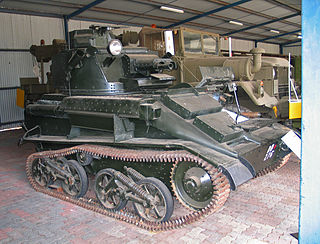 W
WThe Tank, Light, Mk VI was a British light tank, produced by Vickers-Armstrongs in the late 1930s, which saw service during the Second World War.
 W
WThe Light Tank Mk VII (A17), also known as the Tetrarch, was a British light tank produced by Vickers-Armstrongs in the late 1930s and deployed during the Second World War. The Tetrarch was originally designed as the latest in the line of light tanks built by the company for the British Army. It improved upon its predecessor, the Mk VIC Light Tank, by introducing the extra firepower of a 2-pounder gun. The War Office ordered 70 tanks, an order that eventually increased to 220. Production was delayed by several factors and, as a consequence, only 100 to 177 of the tanks were produced.
 W
WThe Tank, Light, Mk VIII (A25), also known as the Harry Hopkins, after American President Roosevelt's chief diplomatic advisor, was a British light tank produced by Vickers-Armstrong during the Second World War. The Mk VIII was the last in the line of light tanks the company had built for the British Army, and was intended to be the successor of the previous light tank designed by Vickers-Armstrong, the Mk VII Tetrarch. A number of changes were made to the Mk VIII, most notably increasing its width, length and weight and also increasing the thickness of the armour. The design of the tank was submitted to the War Office in late 1941, with an initial order for 1,000 models being made by the Tank Board of the War Office in the same month, a number that increased to 2,410 in November. Production began in June 1942 but immediately began encountering problems with the tank, and a number of modifications had to be made to the design after complaints were made by the War Office and the Fighting Vehicle Proving Establishment. These problems were so acute that only 6 tanks had been produced by mid-1943, and only 100 when production ended in February 1945.
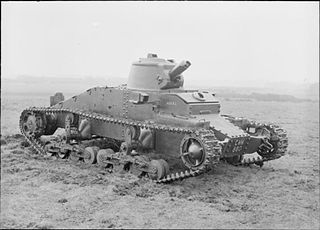 W
WThe Tank, Infantry, Mk I, Matilda I (A11) was a British infantry tank of the Second World War. Despite being slow, cramped and only armed with a single machine gun, the Matilda I had some success in the Battle of France in 1940, owing to its heavy armour which was proof against the standard German anti-tank guns. It is not to be confused with the later model Tank, Infantry Mk II (A12), also known as the "Matilda II", which took over the "Matilda" name after the Matilda I was withdrawn from combat service in 1940. They were completely separate designs.
 W
WThe Infantry Tank Mark II, best known as the Matilda, was a British infantry tank of the Second World War.
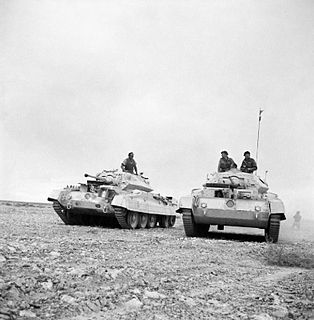 W
WNuffield Mechanizations and Aero Limited, also known as Mechanizations and Aero Ltd and Nuffield Mechanizations Ltd was Lord Nuffield's personal enterprise developing improved methods for mechanisation and mobility of the British Army and the ground section of the Royal Air Force.
 W
W"Rhino tank" was the American nickname for Allied tanks fitted with "tusks", or bocage cutting devices, during World War II. The British designation for the modifications was Prongs.
 W
WThe Sherman Firefly was a tank used by the United Kingdom and some Commonwealth and Allied armoured formations in the Second World War. It was based on the US M4 Sherman, but fitted with the powerful 3-inch (76.2 mm) calibre British 17-pounder anti-tank gun as its main weapon. Originally conceived as a stopgap until future British tank designs came into service, the Sherman Firefly became the most common vehicle mounting the 17-pounder in the war.
 W
WThe Tank, Heavy, TOG II* was a prototype British tank design produced in the early part of the Second World War in case the battlefields of northern France devolved into a morass of mud, trenches and craters as had happened during the First World War. When this did not happen the tank was deemed unnecessary and the project terminated. A development of the TOG I design, only a single prototype was built before the project was dropped.
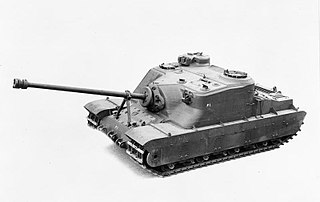 W
WThe Tortoise heavy assault tank (A39) was a British heavy assault gun design developed during the Second World War, but never put into mass production. It was developed for the task of clearing heavily fortified areas such as the Siegfried Line and as a result favoured armour protection over mobility.
 W
WThe Tank, Infantry, Mk III, Valentine was an infantry tank produced in the United Kingdom during the Second World War. More than 8,000 of the type were produced in eleven marks, plus various specialised variants, accounting for approximately a quarter of wartime British tank production. The many variants included riveted and welded construction, petrol and diesel engines and a progressive increase in armament. It was supplied in large numbers to the USSR and built under licence in Canada. Developed by Vickers, it proved to be both strong and reliable.
 W
WThe Tank, Infantry, Mk III, Valentine was an infantry tank produced in the United Kingdom during the Second World War. More than 8,000 of the type were produced in eleven marks, plus various specialised variants, accounting for approximately a quarter of wartime British tank production. The many variants included riveted and welded construction, petrol and diesel engines and a progressive increase in armament. It was supplied in large numbers to the USSR and built under licence in Canada. Developed by Vickers, it proved to be both strong and reliable.
 W
WThe Tank, Infantry, Valiant (A38) was a British tank design of the Second World War that only reached the prototype stage. Intended to meet the specification for a lightweight but heavily armoured tank for use in the war in the Far East, it proved to be a failure. The sole example was retained by the School of Tank Technology after the war as a lesson to its students.
 W
WThe Vickers 6-Ton Tank or Vickers Mark E was a British light tank designed as a private project at Vickers. It was not purchased by the British Army, but was picked up by many foreign armed forces. It was licensed by the Soviets as the T-26. It was also the direct predecessor of the Polish 7TP tank.
 W
WThe Vickers Medium Mark II was a British tank built by Vickers in the Inter-war period.